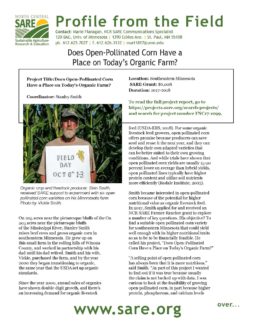On 205 acres near the picturesque bluffs of the Mississippi River, Stanley Smith raises beef cows and grows organic corn in southeastern Minnesota. He grew up on this small farm in the rolling hills of Winona County and worked in partnership with his dad until his dad retired. Smith and his wife, Vickie, purchased the farm, and by the year 2000, they began transitioning to organic, the same year that the USDA set up organic standards.
Since the year 2000, annual sales of organics have shown double-digit growth, and there’s an increasing demand for organic livestock feed (USDA-ERS, 2018). For some organic livestock feed growers, open-pollinated corn offers promise because producers can save seed and reuse it the next year, and they can develop their own adapted varieties that can be better suited to their own growing conditions. And while trials have shown that open-pollinated corn yields are usually 15-20 percent lower on average than hybrid yields, open-pollinated lines typically have higher protein content and utilize soil nutrients more efficiently (Rodale Institute, 2005).
Smith became interested in open-pollinated corn because of the potential for higher nutritional value as organic livestock feed. In 2017, Smith applied for and received an NCR-SARE Farmer Rancher grant to explore a number of key questions. His objective? To find a suitable open-pollinated corn variety for southeastern Minnesota that could yield well enough with its higher nutritional traits so as to be financially feasible. He called his project “Does Open-Pollinated Corn Have a Place on Today’s Organic Farm?”
“A selling point of open-pollinated corn has always been that it is more nutritious,” said Smith. “As part of this project, I wanted to find out if it was true because, usually, the claim is not backed up with data. I was curious to look at the feasibility of growing open-pollinated corn, partly because higher protein, phosphorous, and calcium levels contained in open-pollinated corn would be an important benefit for livestock producers.” He added, “The economics are another factor. Open-pollinated corn seed costs about one-third that of the more ‘modern’ corn varieties.”
The nutritional value of open-pollinated corn was Smith’s major concern entering this project; he was particularly concerned with protein. With the SARE grant funds, Smith looked at six open-pollinated corn varieties and one hybrid, comparing yields and protein content.
“Sellers have mentioned better nutrient values, but I’ve never seen actual results from feed analysis,” said Smith. “The laboratory results verify that the open-pollinated corn I tested through this project all had higher protein levels compared to the hybrid I used in this trial. Most were close to two percent higher.”
He found that all but one of the open-pollinated corn varieties in his plot had protein levels over 10%. The check tested the lowest at 8.41% protein. To make it more clear what a 2% difference in protein content would mean for a producer, Smith provided a brief analysis comparing the nutrient content and economics of organic corn livestock feed with an 8.2% protein level to feed with a 10.2% protein level.
“A 16% feed ration with soybean meal at 46% and corn at 8.2% protein would mean 20.6% meal and 79.4% corn,” explained Smith. “This would produce feed costing $21.54 per 100 pounds, not counting other additives needed. A ration using corn with 10.2% protein would use 16.2% meal and 83.8% corn costing $20.38 or a savings of $1.16 per 100 pounds.”
As for yields, the highest-yielding varieties in Smith’s trial were crosses of one or more different open-pollinated corns, and he intends to do more crosses going forward.
“My objective was to find open-pollinated corn that could compete with hybrids on today’s market. This was achieved with finding a couple of open pollinated corns that did well in southeast Minnesota,” said Smith. “The other objective was to see if today’s open-pollinated corn still held an advantage in nutritional value. This was also verified with all six varieties having higher protein levels than the check hybrid.”
A field day at his farm and a video on NCR-SARE’s YouTube channel have generated interest, and Smith’s been fielding emails about the project. He hopes someone will look at his protein results and take his project further with a feeding trial. He says creating new open-pollinated corn varieties should be pursued, especially for organic farmers.
“When high protein, higher-yielding open pollinated options become available, I would expect more small seed producers to sell locally grown seed, and some small growers to save their own seed, reducing production costs considerably,” said Smith.
Watch a video of Stan Smith talking about his SARE project.
